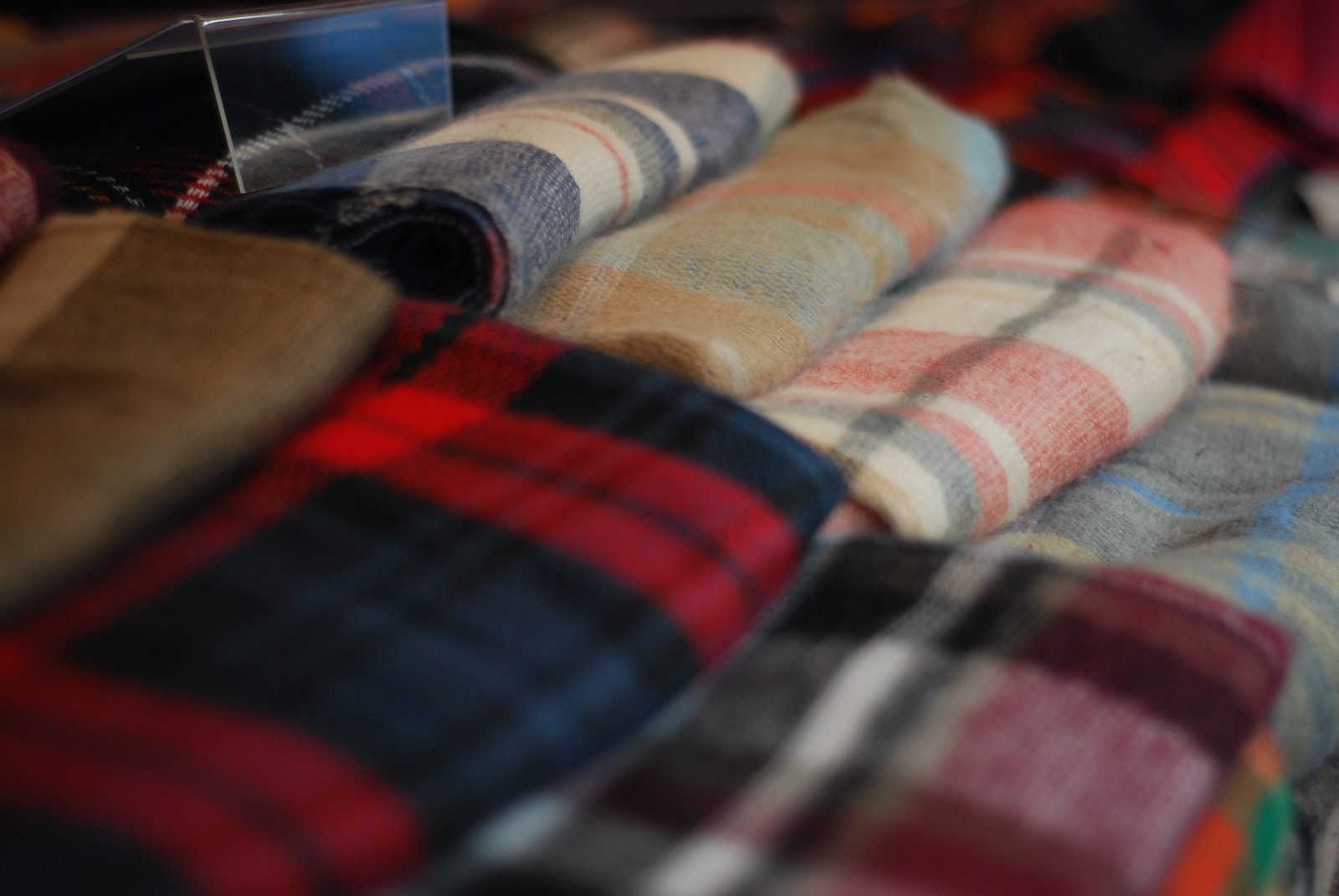Fabric patterns have long fascinated and intrigued individuals across cultures, serving as a visual representation of history, traditions, and personal style. Plaid and tartan are two such patterns that often evoke confusion due to their similar appearance. However, discerning the dissimilarities between these patterns is crucial in order to appreciate their unique significance and avoid misinterpretation.
Brief explanation of plaid and tartan as fabric patterns
Plaid is a fabric pattern characterized by crisscrossing lines or checks of different colors or widths. Its origins can be traced back to the Scottish Highlands, where it was traditionally woven from wool.
The word “plaid” is derived from the Scottish Gaelic word “plaide,” meaning blanket or shawl, reflecting its early uses in clothing for protection against harsh weather conditions. Tartan, on the other hand, is a more specific type of fabric pattern that falls under the umbrella term of plaid.
It consists of vertical and horizontal stripes that intersect to form various repeating geometric designs known as setts. Tartan has deep cultural significance in Scotland and has historically been used to distinguish different clans or families through distinct color combinations and sett arrangements.
Importance of understanding the difference between the two
Gaining a clear understanding of the distinction between plaid and tartan holds immense value for both fashion enthusiasts and those interested in cultural history. By properly identifying whether a pattern is plaid or tartan, individuals can make informed choices regarding how they incorporate these fabrics into their wardrobe or interior design projects.
Moreover, comprehending the difference helps prevent misappropriation or misuse of these culturally significant symbols. Misrepresenting tartans can inadvertently offend those who hold deep connections to specific clans associated with particular setts and colors.
By delving into the unique characteristics of plaid and tartan, we can unravel their rich histories and appreciate the significance they hold. Understanding this distinction enables us to make informed choices when it comes to fashion, design, and cultural appreciation.
Plaid: An Overview
Definition of plaid
Plaid is a fabric pattern characterized by crisscrossing lines or checks, typically woven with different colored yarns crossing each other at right angles. The term “plaid” originally referred to a specific type of woolen cloth worn by the Highlanders in Scotland.
However, over time, it has come to represent not only the fabric itself but also the distinctive pattern it embodies. Plaids can feature various color combinations and sizes of checks, lending them versatility in design.
Historical origins and cultural significance
Plaid holds deep historical roots in Scotland and has been an integral part of Scottish cultural heritage for centuries. The origins of plaid can be traced back to the traditional tartan patterns worn by Scottish clans, primarily those residing in the Highlands.
These clans used specific tartans as a means of identifying their affiliation and allegiance within their communities. The association between plaid and Highland clans stems from the practicality and durability of this fabric pattern in rugged terrains.
The dense weave provided warmth and protection against harsh weather conditions prevalent in the Scottish Highlands. Moreover, plaids were often used as cloaks or blankets by warriors during battles due to their versatility.
Evolution of plaid in fashion and popular culture
While its origins lie deeply rooted within Scottish culture, plaid transcended its utilitarian beginnings to become an iconic fashion statement worldwide. In the late 18th century, plaids gained popularity outside Scotland when tartans were introduced into fashionable society through influential figures like King George IV’s visit to Edinburgh wearing Highland dress.
Through subsequent years, plaids became associated with rustic charm and outdoor activities due to their connection with Scottish landscapes. They found favor among country gentlemen during hunting expeditions as well as among those seeking a timeless yet casual style.
In the early 20th century, plaid fabrics found their way into mainstream fashion, being employed in everything from tailored suits to skirts and dresses. Today, plaid remains a beloved pattern across the globe and is widely embraced in fashion and popular culture.
Its versatility is evident in its use across different clothing styles, accessories, home decor items like blankets or curtains, and even as a design choice for products such as phone cases or wallpaper. Plaid continues to evolve and adapt to contemporary trends while retaining its timeless appeal and connection to heritage.
Tartan: An In-Depth Exploration
Definition of tartan
Tartan can be defined as a distinct fabric pattern characterized by a checked design formed through the interweaving of different colored threads. This intricate weaving technique results in a visually striking crisscrossing pattern, creating a unique and captivating aesthetic. Tartans are typically made from wool but can also be crafted from other materials such as silk or cotton, depending on their purpose and desired effect.
Origins and historical context
To truly understand tartan, one must delve into its rich historical origins. Ancient Celtic civilizations were among the first to develop this pattern, with evidence dating back thousands of years. The Celts used natural dyes derived from plants and minerals to create vibrant colors in their fabrics, infusing them with symbolism and cultural significance.
In later centuries, tartan gained prominence as a means of identifying Scottish clans. Each clan developed its own unique tartan pattern, which served as an emblem of clan membership and loyalty.
Tartans became an essential part of Scottish culture and heritage, intimately linked to the concept of kinship and familial connections. However, during the Act of Proscription between 1746-1782 following the Jacobite rebellion in Scotland, wearing tartan was banned as an attempt to suppress Highland culture.
This period marked a challenging time for Scottish traditions, including the use of tartans. Nevertheless, after the ban was lifted in 1782, tartans experienced a resurgence in popularity while holding onto their deep-rooted historical significance.
Traditional tartans and their meanings
Tartans encompass a wide array of patterns that reflect regional variations and clan associations. Regional tartans are inspired by specific geographic areas within Scotland and often showcase colors that represent distinctive landscapes or natural features unique to these regions.
Clan tartans, on the other hand, hold immense familial significance. Each clan has its own designated tartan that bears its name, and members proudly wear these patterns to display their ancestral roots.
The complexity of clan tartans lies in their sett patterns, which are meticulously designed arrangements of horizontal and vertical stripes that create distinct motifs. These setts serve as a visual language, representing the identity and history of each clan.
Colors also play a significant role in tartan design. Traditionally extracted from natural materials such as plants, berries, and mosses found in Scotland’s lush landscape, each color holds symbolic meanings.
For instance, green may represent agricultural prosperity or forested areas, while blue can evoke the vastness of Scottish lochs or the sky above the Highlands. The combination and arrangement of colors within a tartan serve to tell stories and evoke a strong sense of heritage.
Differentiating Plaid from Tartan
Similarities between plaid and tartan
Both plaid and tartan are fabric patterns characterized by crisscrossing lines or checks. This similarity often leads to confusion between the two terms.
Additionally, both plaid and tartan find common usage across various aspects of everyday life such as clothing (kilts, scarves), accessories (handbags), or home decor items (throws). Despite these shared characteristics, it is important to recognize their distinct features.
Key differences between plaid and tartan
The differences between plaid and tartan lie primarily in their structure and cultural associations. Structurally speaking, plaids are often woven with different colored yarns crossing each other at right angles without adhering to specific repeatable patterns.
Plaids tend to have more flexibility regarding color combinations and check sizes due to their freestyle design approach. Conversely, tartans possess specific setts – predetermined arrangements of colored threads that repeat both horizontally and vertically.
These setts create recognizable, standardized patterns unique to each tartan. The repetition of setts allows for the reproduction and identification of specific tartans across different fabrics consistently.
Culturally, plaids are more commonly associated with casual wear or outdoor activities due to their simplicity and versatility. Tartans, on the other hand, bear deep-rooted connections to Scottish heritage and clans, symbolizing familial ties and ancestral pride.
Conclusion
As we explore the difference between plaid and tartan, we uncover not only their structural dissimilarities but also the fascinating historical contexts that shape their meanings today. Tartans hold a profound significance in Scottish culture as emblems of clan affiliation and a testament to ancestral heritage. Plaids, although often confused with tartans due to their similar appearance, are more loosely defined fabric patterns that find diverse applications in fashion and lifestyle.
Understanding these distinctions not only enriches our appreciation for these cherished fabric patterns but also enables us to connect with the cultural narratives woven into every thread. So whether you opt for a dashing tartan kilt or a cozy plaid blanket on a chilly evening, may you embrace the beauty and significance behind these timeless designs while celebrating your own unique style.
 Skip to main content
Skip to main content


